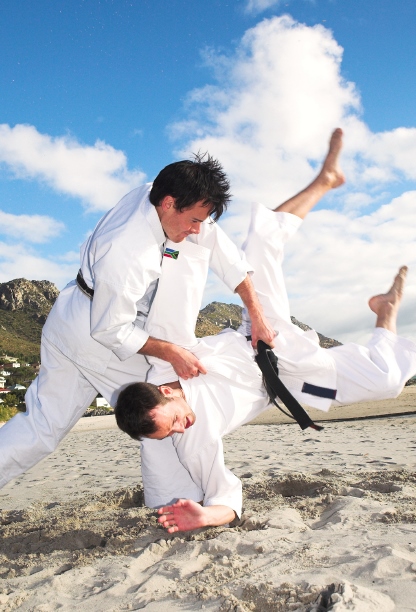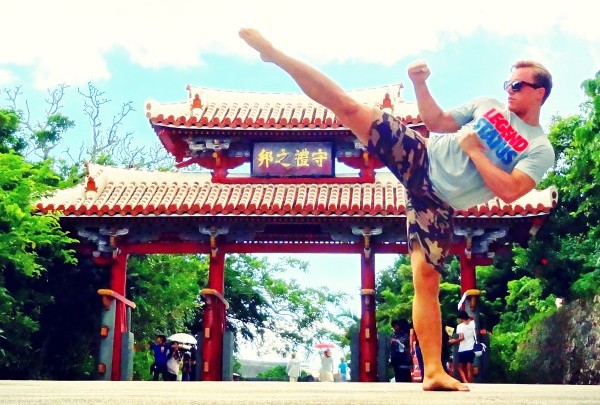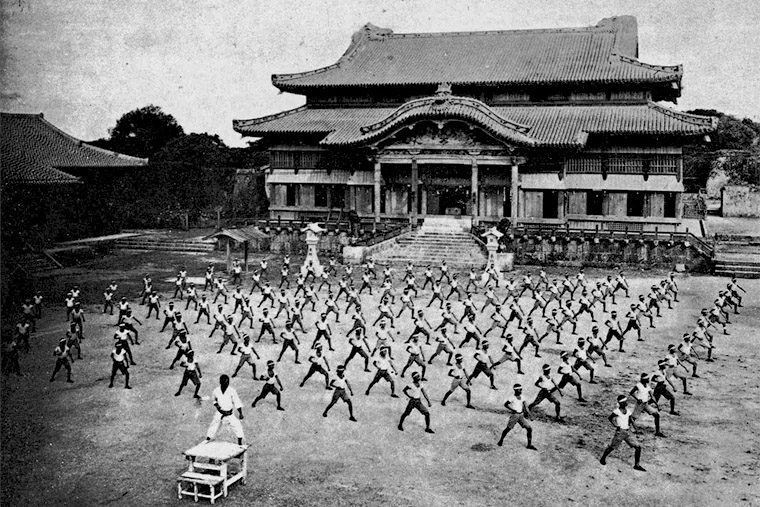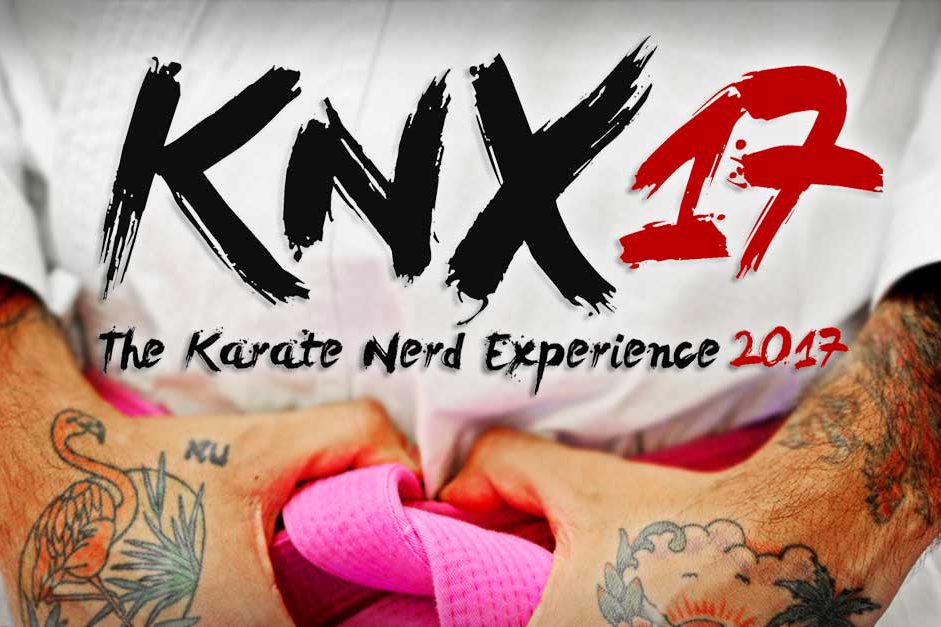Okinawa…
This “mythical” island southwest of Japan, where Karate was born.
Wouldn’t it be cool to visit once?
Heck yeah!
Okinawa, or “Uchinaa” (as the locals call it), is a special place for Karate people to visit. There’s much to discover around the island – both in the regular tourist sense, and in the Karate Nerd™ sense.
Believe me, I used to live there.
For instance, as my most dedicated readers will remember, during my own travels around Okinawa I’ve personally both infiltrated the last living Funakoshi super-granny clan, discovered the holy burial place of master Kyan Chotoku, found the unknown hideout of Tomari-te legend Kosaku Matsumora, dug up the secret weapon of legendary Karate warrior Bushi Matsumura and much, much more.
But you’re not like me…
You’re smarter!
When you go to Okinawa, you don’t want to spend your few precious days running around barefoot in the jungle, getting bit by mosquitoes, searching for ancient graves, sweating gallons, kicking in front of old castles, ducking bats during night training, or wasting all your money on repulsive bean goo.
Oh no.
You want to use your time in Okinawa wisely!

So, today I’ve invited my dear friend Miguel Da Luz – founder of the Okinawa Traditional Karate Liaison Bureau – to teach you all about the essentials of training Karate in Okinawa as a foreigner.
Miguel-san has lived in Okinawa for 20 years and is the “main man” when it comes to connecting Okinawan Karate masters with foreigners (together with my friend James-san at the famous DOJO Bar).
Trust me – being a foreigner in Okinawa is not easy.
There’s a LOT of stuff that can go wrong when you visit Okinawa for training Karate the first time.
I learned this the hard way – like one time, when I was literally half an inch away from getting my nose broken by a 9th dan ex-world champion grandmaster, due to a simple linguistic misstep.
Read this guide carefully…

Let’s go!
“What are the top 3 most important advice for people who want to visit Okinawa for training Karate?”
- Attitude: Most of the time, you will be welcomed in a real Okinawan dojo, not a gym or a martial center. Here in Okinawa, a dojo is like a family. It is a concept hard to understand if you have never been to Japan; the sensei is like the father, the sempai are the oldest brothers and the regular students are like young kids! Without a doubt, you have to be respectful to all members of the “family” as they generously welcome you in their home – the dojo itself.
- Ask questions: The student: “Why didn’t you tell me?” The master: “Because you never asked!”. I would suggest asking questions as much as possible to the master or other dojo members. If you are not supposed to know the answer, or they don’t want you to know, they won’t answer. But most of the time, they will answer or give clues. You shouldn’t be too persistent or inquisitive though, but frankly I think there is a lot to be learned beyond the physical practice – both in the cultural, historical and spiritual aspects of Karate. And if you don’t speak Japanese, find an interpreter!
- Tuition fee: In a way, I believe people should see “training in Okinawa” as if they were going to join a seminar like many often do in their respective country. Therefore, paying a training fee is a normal and respectful etiquette, even if the masters do not ask for anything. To do so, don’t flip your wallet out of your pocket and pay. Find a simple envelope before going to the dojo for the first session, insert the money and hand it politely to the master with a bow. Most of the time, it is not the amount inside that matters, but the attitude.
“What is the best protocol/etiquette for contacting and training in an authentic Okinawan dojo?”
In the past, one needed an introduction letter from a reliable and trusted person to be accepted by a master.
Today, however, more instructors are open to teaching unknown foreigners – but still it is easier and faster if you are introduced by someone. For decades, Nakasone Kenzo, owner of the Karate shop Shureido, has been helping those who came to Okinawa. Today, next to Shureido, my Okinawa Traditional Karate Liaison Bureau (OTKLB) acts as an intermediary between martial artists around the world and local masters, so people can plan and be sure to practice as soon as they land.
But regardless of the channel, it is important to be frank about what it is you do, the schools or organizations you belong to and the masters you trained with in the past. For you to be allowed to train in an Okinawan local dojo, trust is an important matter – so make your intentions clear. Are you looking for training and exchange, grading, affiliation…? There are many people with many goals. Regardless of what you are looking for, you will be accepted or not.
And just for the record, very few Okinawan masters will ask you to join their organization or give you a higher rank after one visit!
“What are the top 5 most “foreigner friendly” traditional dojos in Okinawa?”
Living in Okinawa and interacting a lot with the local Karate community, this is a politically hard question to answer.
However, from my experience in helping people not affiliated with local organizations, I would say in no particular order:
- Kyudokan of Higa Minoru sensei (Shorin-ryu)
- Shubukan of Uema Yasuhiro sensei (Shorin-ryu)
- Jundokan Sohombu of Miyazato Yoshihiro sensei (Goju-ryu)
- Kenshinkai of Hokama Tetsuhiro sensei (Goju-ryu)
- Shimbukan of Akamine Hiroshi sensei (Ryukyu Kobudo)
As you know, there are some 400 dojo in Okinawa and many organizations have their own worldwide network and overseas branches. These five are just a part of the tip of the iceberg.
Just remember, Okinawan Karate is different from Japanese Karate.
Related reading: 10 Differences Between Okinawan Karate & Japanese Karate
“What are the top 5 “must-see” places for Karate people visiting Okinawa and why?”
- Downtown Naha: You can find good Karate everywhere in the world. But the Okinawan atmosphere is only in Okinawa. Downtown Naha (the “capital” of Okinawa) might seem obvious, but people who visit Okinawa should really open their eyes more when they go here. One famous proverb says that “Karate is not only in the dojo or when with the master”. There are so many things to see in Naha that are more or less connected to Karate: More than 150 dojo in the city itself, monuments and sites, old areas that remind of ancient Ryukyu Kingdom, performing arts where the dance moves resemble Karate… But for that, you need to look around, and more importantly, be open and receptive.
- The Budokan: Home of most of Okinawa’s major Karate events, you must visit it once for the many martial arts that can be seen and practice there, and the many people, famous or less famous, that you will encounter in the premises.
- Karate museums: Nakamoto Masahiro sensei and Hokama Tetsuhiro sensei’s private museums are a must-see when coming to Okinawa. Call before to ask for a private visit. Kinjo Masakazu sensei also has a really impressive collection of kobudo weapons and he welcomes people on a “per request” basis.
- The Makabi cemetery: There are many monuments and sites related to Karate and its history, as stated. This cemetery however, located between Naha and Shuri, is incredible as this is where many old masters are actually resting: Matsumura Sokon, Itosu Anko, Hanashiro Chomo and many others…
- Gangara no Tani & The Bugei Cave: A great walk in an ancient valley that leads to a place where Kobudo was secretly practiced in the past. Located close to the Okinawa World, there is a fee, but the walk is really nice!
Allow me to make it the “top 6 must-see places” so I could add the Dojo Bar. Even though I am sure most visitors will find it easily, this place is a great hang-around for many Karate enthusiasts who visit or live in Okinawa. (Note: Make sure to order the KARATEbyJesse coctail (seriously!) and tell James-san that I sent you).
“What is the #1 mistake most foreigner make when they come to Okinawa to practice Karate?”
I could list quite a few but I would say, the wish to train simultaneously in various different dojo or different styles while on island.
While it is OK to take seminars with different masters overseas, Okinawa is a small island and fidelity to a clan or a school is primordial. Many of the local masters do not appreciate having their students (especially direct ones) or trainees go training “here and there”. As I said before, remember that you are entering a family of sorts. So, if you intend to “go fishing”, make sure that every one involved (the masters and the ones acting as intermediary) know in advance to avoid any later problems.
It is foolish to think that “He won’t know if I went here and there” because the masters will hear about it one way or the other and it might ruin relationships. One should stick to a master to fully appreciate “the Way”.
Still, if you want to go visit other styles while on island, a good way is to simply ask your welcoming instructor for advice on which dojo they would recommend for a visit. It is a nice way to have some doors open for you the traditional way! And most of the time, it will lead to great discoveries.
“What are the 3 best hidden “secrets” from foreigners in Okinawa?”
As you already know, there are no so-called “secrets”. It is just a matter of discovering new things and clearing confusing matter along the way. Like with any other martial arts, coming to the birthplace or living there offers the luxury of experiencing unique aspects of the culture and society of the place. But then still, you need time to really understand what’s below the surface.
So, thinking about some aspects that could be experienced or researched while on Okinawa, I could mention:
- Mura-bo: Many Karate-ka know or even practice Kobudo. But Mura-bo, the “village staff” performed in some local festivals is a must-see if you visit Okinawa. I know that some Kobudo masters look down on it, but in some areas I believe it is performed beautifully, martially speaking. Maeda-bo, Yomitan-bo, Sashiki-bo, Kochinda-bo, you name it… One particularly impressive event is Itoman Maezato tug-of-war and the Maezato village’s men of bo! If interested, I suggest that when you are planning a trip to Okinawa, you check for possible event dates.
- Okinawa sumo: It is the same for the local sumo. Nagamine Shoshin sensei in his last book mentioned the relation between Okinawan sumo and Karate. While many people know Japanese sumo, the Okinawan version of sumo is quite different and worth watching.
- Kusu: Although awamori (the Okinawan distilled liquor) is not a secret, in too many cases foreigners taste regular and low degree awamori with a lot of water and ice and decide that awamori is not that good! Well, I would advice to taste some kusu or vintage awamori to better enjoy Okinawan nights. Jokingly, I like to see awamori as the petrol or gas that makes many Okinawan Karate-ka have a “formidable machine” that run so well. And if you are lucky, you might even have a taste of a similar secret, Uechi-gusa…
“What are the most important Japanese phrases foreigners should memorize before visiting Okinawa?”
The all purposes “Yoroshiku onegai shimasu” for “Please” and “Arigato gozaimashita” for “Thank you” are a must. But don’t shrink these expressions to “Yokoroshiku” and “Arigato” as it might be rude depending to who you are talking to.
Of course, counting from one to ten (“Ichi, ni, san, shi…”) in Japanese, to blend in with the others in the dojo when repeating millions of punches and blocks is a must too.
“Konnichiwa” (“Hello”) to be said a bit loudly to announce your arrival, and “Watashi no namae wa (insert your name here) desu” for “My name is… “.
But today, many dojo have people who speak some English so I wouldn’t worry too much about language. You can also pick up some original Okinawan words (“Haisai” = “Hello“!) to impress your audience but don’t overdo it. Depending on who you are talking to or the situation, it might not even be to your advantage.
Finally, PLEASE, no “OSS!” This modern Western/mainland Japanese expression is NEVER used in Okinawa and will make you look like a mainland Japanese Karate-ka who does NOT understand the Okinawan customs!
Related reading: The Meaning of “Osu” / “Oss” (+ When You Should NEVER Say It)
“What are your 2 favorite moments from your life as a “Karate connector” in Okinawa?”
- My relation with Taba Kensei sensei: In 2006, while I was preparing an article on the late Nagamine Shoshin sensei that would later be published in Okinawa Karate News no. 14 (note: I was interviewed by Miguel in Okinawa for issue no. 62, when I released my #1 Amazon best-seller The Karate Code), I interviewed Taba sensei in Itoman village. Since then and until his passing in July 2012, he was very nice to me anytime I met him, giving me advice both technically and spiritually, although I was not in his organization and rather new to him. For me, he represented the true image of a Karate master. And even after his passing, I was privileged to have access to some of his vast knowledge only because Taba sensei himself said on his death bed that he trusted me with promotion of true Karate worldwide, dixit one of his top students! This adds to my feelings of “Ongaeshi” or “Giving back for what you have been given”.
- Higaonna sensei’s finger on me: I think the following occurred during the 2003 Okinawa world tournament seminars (note: read my 2009 report on the world seminars here). I was interpreting for Higaonna Morio sensei in his seminar. To his left was his assistant and I was standing to his right. He performed one of his favorite “seize the opponent’s finger, break it and simultaneously smash your other hand in his chest.” Having demonstrated the technique on his left hand assistant, he suddenly turned to me, asked that I seized his gi so he could demonstrate on the other side. Automatically obeying, he performed the technique a few times on me! Later I thought “Wasn’t I supposed to be the interpreter?!” Well, I went home happy with a twisted finger and a few nice marks of his hand on my chest. But the most fun thing about this moment was the faces of the participants who, thinking I was just a guy translating, told Higaonna sensei to stop. His answer to them, “It’s OK, he is one of us!” made me feel good!
Related reading: 2 Forgotten (But Deadly) Techniques of Okinawan Karate
“Last words to people visiting Okinawa for Karate?”
Remember that in this interview I have been speaking exclusively for those with no connection or affiliation to a local Okinawa organization. Whether it is through the internet, through locals, the OTKLB, or through someone who has been there and can introduce you, you’d better prepare your visit so you don’t lose time wandering for a dojo.
It still happens often. People thing: “Okinawa is the cradle – we’ll find a dojo easily.”
Big mistake!
While many people can certainly help you, you need to really prepare your stay in advance thoroughly. That means, more than just a couple of weeks before. Many of the masters ready to welcome you are busy in Okinawa and overseas – so plan correctly to get the most of your trip!
Good luck!
That concludes this practical foreigner’s guide for training Karate in Okinawa – the birthplace of Karate.
Got questions? Leave a comment.
See you in Okinawa! ;- )
/Jesse



82 Comments